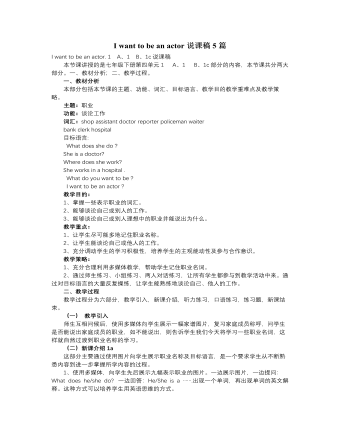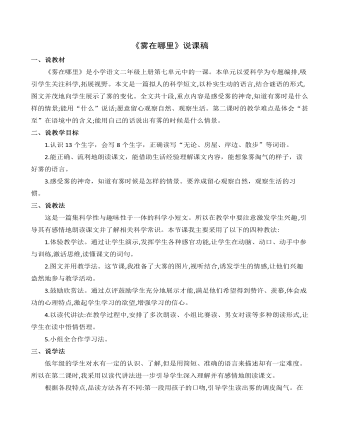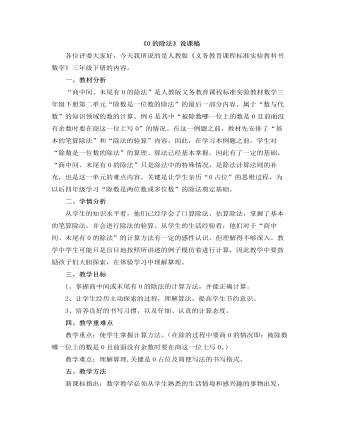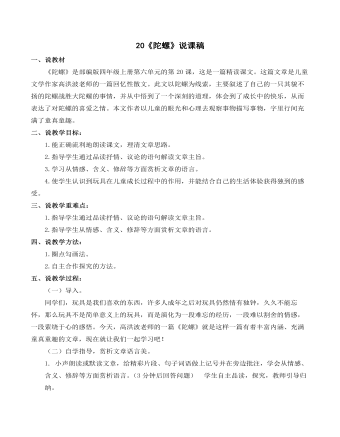人教版新目标初中英语八年级上册I’m going to be a basketball player说课稿8篇
-
- 页数:31页
- 字数:约 36181 字
- 大小:388.00KB
- 格式:.doc
- 版本:Office2016及以上版本
- 作者:大猫丶演示
I’m going to be a basketball player说课稿8篇
I’m going to be abasketball player. Section A Period1说课稿
一.说教材
1.教材的地位与作用:Unit10 I’m going to be a basketball player. 这单元通过复习和学习一些关于职业的词汇,用be going to谈论长大以后打算做什么以及打算怎样实现目标,与七年级(下)I want to be an actor. 学习关于职业的词汇以及用want to be\do谈论将来,和八年级(上)What are you doing for vacation?用be doing谈论将来的打算有着密切的联系。本课是这单元的第一课和重点课,学好本课将为进一步学习一般将来时打下良好的基础。

2.教学目标:
(1).知识目标:掌握本课重点词汇computer programmer, computer science,engineer, pilot, professional ….本课主要句型:What are you going to be when you growup? I’m going to be an engineer. How are yougoing to do that? I’m going to study math hard.
语法:用be going to表示一般将来时。
(2).能力目标:培养学生应用英语谈论将来计划,提高学生听、说、读、写等能力。
(3).情感目标:通过谈论将来打算做什么以及准备怎样实现目标,让学生考虑自己的将来,及早为将来做好准备。同时让学生意识到光有伟大的理想是不够的,还要为了这一理想而脚踏实地地努力学习。培养学生学习英语的强烈兴趣,乐于参加各种活动的积极情感,善于合作,培养学生团结协作精神。
(4).教学重、难点:重点是掌握本课 computer programmer, computer science,engineer, pilot, professional等重点词汇,What are you going to be when you growup? I’m going to be an engineer. How are yougoing to do that? I’m going to study math hard.等重点句型和语法:用be going to表示一般将来时。
难点是一般将来时be going to 中be 的具体形式和后面接动词原形的用法, 而学生根据自己喜欢的职业,运用所学知识谈论自己打算怎样做来实现目标则既是难点,又是能力训练点。
二. 说教法
1.“Teach English in English”: 即新课标倡导的“用英语教英语”,尽量用英语教学,创造英语课堂良好的听的环境,让学生充分感知,积极体验,大胆实践,把握用英语交际的机会,鼓励学生大胆开口说英语。
2.突出重点,突破难点:通过听力训练、做调查、小组竞赛等多种形式反复操练重点句型,巩固所学知识,提高灵活运用能力,通过操练中人称的变化和幻灯片展示帮助学生更好地领会语法。
3.任务型教学法:倡导体验参与,培养自主学习能力。课前布置任务,要求学生复习七年级(下)Unit 4中关于职业的词汇,预先读本课新词,让学生带着任务有目的地上课,并在课堂学习中不断获得完成此任务所必须的知识、能力、技能等,为最终完成任务作全面的准备。
4. 游戏教学法:新课标倡导的“玩中学,学中玩”的理念很受学生欢迎。设计环节请同学表演How are you going to do that?既达到以旧带新的目的,又有效地激发了学生的学习兴趣,活跃了课堂气氛。
5.竞赛教学法:根据初中生争强好胜的性格特征,在课堂内引进小组竞争机制,提高团体活动效率,加强团体凝聚力,激发学生的求知欲和参与意识。
6.借助多媒体辅助教学,形象、生动,使课堂容量相对增加,给学生提供更多的语言实践机会,有利于综合语言运用能力的提高。
7.教具:电脑多媒体、职业道具、录音机等。
三.说学法
1. 学会预习:发挥学生的主观能动性,变被动学习为主动学习,带着问题有目的地听课,可以更好地把握课堂的重点和难点,提高课堂效率。
2.在游戏中学习:在“玩中学,学中玩”,好玩是学生的天性,让学生轻松学习,体会学英语原来可以这么有趣,提高学习兴趣与热情。
3.合作学习:积极参与2人或4人小组对话或活动,相互交流,互帮互助,合作完成任务,培养团队精神,更好地掌握本课所学知识。
4.“为用而学,用中学,学了就用”:善于抓住用英语交际的机会,充分感知,联系实际,积极体验,大胆实践。
四.说学生:
1.大班教学,学生语言实践机会少,程度不一,整体教学中较难兼顾到具体对象,容易两极分化,通过各种合作学习的活动,可以照顾学习英语有困难的学生,尽可能多地为他们创造语言实践的机会,促使学生互相学习,互相帮助,体验集体荣誉感和成就感,发展合作精神。
2.初中学生脸皮薄,怕犯错,不敢开口,“哑巴英语”的现象比较严重,在教学中关注学生的情感,努力营造宽松、民主、和谐的教学氛围,尊重每个学生,积极鼓励他们大胆尝试,保护他们的自尊心和积极性。
3.中学生活泼、好动、好胜心强、可塑性大,在教学过程中,注意设置情境,倡导其活动参与,并引进小组竞争机制,更好地激发学生的学习兴趣,提高课堂效率。
五.说教学过程:根据英语五步教学法“组织课堂——复习——导入新课——讲授新知识——操练巩固”来开展教学,通过引入姚明的资料,对学生进行提问和启发,复习学过的关于职业的词汇,多媒体展示图片学习关于职业的新单词,通过请同学问答来导入新用法What are you going to be when you growup? 进一步谈论How are you going to do that? 引导学生用be going to 谈论将来的计划,并通过听力训练、做调查、小组竞赛等形式进行操练,使学生更快更好地识记,巩固所学知识,提高灵活运用能力。
6.教学过程:
Step1 Organization and duty report
Step2 Revision
1. Revise the words about jobs byplaying a guessing game.
2. Ask students to say jobs we’ve learned.
通过猜谜的形式复习旧单词, 调动学生的学习积极性。
Step3 Presentation
1. Teach new words and expressionsby showing the pictures.
利用多媒体展示图片引入新词汇,直观、形象,印象深刻。
2. Present What are you going to bewhen you grow up? How are you going to do that?
3. Ask What’s he\she going to be when he\shegrows up? How’s he\shegoing to do that?
结合实际谈论自己的个人成长计划,引导学生谈论自己的将来计划。
Step4 Listening
Listen and match the items in1b,then listen and repeat.
通过听、说、读,进一步巩固所学知识。
Step5 Practice
Ask the students to make aninvestigation about their future plans in groups of four.
通过小组调查活动操练本课重点句型。
Step6 Sum up
In this class we learn to use “be going to” to describe future plans.
通过小结,回顾本课主要内容
Step7 Homework
Read the four conversations in 1b,recite one of them.
Make their own conversation inpairs, write it on the exercise books.
布置两人合作做对话,促使学生加强合作,互相帮助。
I’m going to be abasketball player. Section A 1a—1c说课稿
一、课型:会话课
二、教学时长:40分钟
三、教材分析:
1.教学内容:本课时的教学内容选自人教版义务教育课程标准实验教科书《新目标英语》学生用书八年级上册,第十单元 I’m going to be a basketball player 中Section A 1a-1c。
2.地位和作用:这是第十单元的第一课时的内容,其中心话题是谈论人生理想。通过本课时的学习,学生对 be going to 这一结构表示“将来”会有一定基本的了解,并能初步运用这一语言结构进行交流,为下一节课的学习打下基础,在教学中的地位是举足轻重的。
3.重点:目标词汇和be going to + do结构。
难点:动词一般将来时的用法和基本结构。
四、教学目标分析
1.认知目标
(1)掌握本课时的目标词汇和目标语言。
(2)学习运用 be going to +do 这种结构来谈论对未来的打算。
(3)学会用 what, how与be going to +do结合来提出问题并做出正确回答。
2.能力目标
听能听懂谈论有关人生理想的词汇及表达。
说能运用目标语言进行有关人生理想的谈论。
读能从课文提供的语言材料中获取有关人生理想的信息。
写能运用正确的语言结构写一篇题为 “My Future”的短文。
3.情感目标
通过对人生理想的讨论,让学生从小就树立自己的人生理想,并且下决心为实现自己的理想而努力奋斗,使他们成为有理想、有抱负、有动力、健康成长的新一代青少年学生。
五、学情分析
学生已经在What are you doing for vacation中学会了使用现在进行时表示计划即将着手去做的事(一定要发生的事),对本单元的教学有所铺垫。本单元主要讲授使用be going to +do结构来表述将来的计划或打算(可能会发生、也可能不会发生的事)。
六、教法、学法
教法:任务型教学法
学法:合作式学习法、观察发现法讨论学习法、探索学习法
七、教学手段
多媒体、录音机、黑板等
八、设计理念
本节课抓住初中学生的心理特点,一开始就用他们乐于参与的游戏开局,增强课堂的趣味性、调动学生的积极性和主动性,同时也起到复习的作用。在新职业名称呈现之后,再次引入竞争机制,开展小组竞赛,更进一步活跃课堂,增强生生互动,同时起到新旧知识整合的作用。在目标语言的呈现方面,采用了“以旧引新”的办法,用 want to be结构引出本节课的目标语言be going to + do结构。在听、说能力训练的同时,本节课对读、写能力训练也设计了一定内容(Group work、homework).总之,本节课注重初中学生的心理特征,设计了活泼、有趣、参与性强、参与面广的课堂活动;注重师生互动、生生互动;强调新旧知识的整合;在强化听、说能力的同时,也进行了必要的读、写训练,使各项能力平衡发展。
九、教学过程
Teaching
Procedures
Teacher’s Activities
Students’ Activities
Explanation
Revision
(3 minutes)
Ask one student to come to the blackboard and act out what the teacher tells him (her) to do.
Guess what kind of work he (she) does.
Revise the names of jobs learned before.
Presentation
(4 minute)
Show some pictures to present the new words.
Learn the new words: engineer,
pilot, professional , programmer.
Task 1 (1a)
(5minutes)
 Presentation and drill
Presentation and drill(8minutes)
Ask Ss to write down the jobs they know in groups
Present the new target language: What are you going to be when you grow up?How are you going to do that?
Ss write down the jobs they know on the blackboard.
1. Ss answer the question: What do you want to be when you grow up? 2. Then learn to answer the question: What are you going to be when you grow up? 3. Drill
Arouse interest about ideal jobs
Use the first question to present the phrase “grow up ” and “be going to + do”
Pair work
(5minutes)
Ask Ss to make conversations in pairs
Ss use the target language to talk about their ideal jobs.
Use the names of the jobs learned before
Listening(1b)
(4minutes)
Play the tape record. And check the answers.
Ss listen to the tape and match the items in 1b.
Practice
(8minutes)
Ask the Ss to make interviews about their ideal jobs.
Ss make interviews and report.
Writing and reading practice
Summary
(2minutes)
Summarize the usage of the structure “be going to +do”.
Consolidate the usage of “be going to + do”.
Homework
(1minute)
Ask the Ss to write short passages about their future.
Write an article named My Future.
Board Writing
engineer
pilot
professional
programmer
grow
grow up
What are you going to be when you grow up?
I’m going to be a computer programmer.
How are you going to do that?
I’m going to study computer science.
I am
He/ She/ It isgoing to do
We/ You/ They are
The space is for checking students’ answers.
教学过程(文字说明)
Step1Revision(play a guessing game)
请一位学生到讲台上,老师轻声耳语告诉他(她)某个职业,要求该学生用动作表现出来,教师使用What does he (she) do?向其他学生提问,让学生猜测台上学生所表演的职业,用以复习以前所学职业名称:singer, actor, dentist, basketballplayer, doctor等。(3分钟)完成任务所需要语言结构:
Ishe / she a (an)……
Whatdoes he /she do?
He/She is a (an)……
[目的] :复习与本单元的教学内容有关的职业名称和句型。
Step 2.Presentation
利用新图片继续进行问答,用以呈现新单词professional,programmer,engineer,pilot。完成任务所需要语言结构:
Ishe / she a (an)……
Whatdoes he /she do?
He/She is a (an)……
[目的]:通过这个环节,学生进一步学习与谈论职业和人生理想相关的新单词,为新课的展开做好铺垫。
Step 3. Task(1a)
根据班内自然组分组,要求各组集体讨论并在黑板上写出他们所知道的职业,各小组所写内容不能重复,比一比,看哪个小组写得最多、最快。
[目的]:通过比赛,进一步引起学生对未来职业的兴趣,为下一步谈论理想做好铺垫。
Step 4. Presentation and drill
1. Presentation
设置问题,与学生谈论他们的理想,用以呈现新句型be going to+do。完成任务所需要语言结构:
What do you want to do when you grow up?
I want to be an actor.
用上述句型来引出下列目标语言:
What are you going to be when you grow up?
I am going to be a …… ?
How are you going to do that?
I’m going to ……
2. Drill
采用师生问答、生生问答的方式,鼓励学生使用上述新学目标语言进行半开放式操练。
[目的]:联系学生的实际想法,鼓励学生积极参与讨论,激发学生的学习兴趣,让学生掌握 be going to + do的用法。
Step 5. Pair work (1c)
要求学生用新学句型结合已有有关职业知识进行开放式操练。完成任务所需要语言结构:
What are you going to be when you grow up?
I am going to be a ……?
Why do you want to be ……
Because……
How are you going to do that?I’m going to ……
………
[目的]:采用开放式的操练,进一步强化目标语言的运用、加强新旧知识的进一步整合。
Step 6.Listening
通过前一阶段的学习和操练,要求学生完成59页的练习1b的听力训练。
[目的]:对本节课所学的词汇和目标语言从听力上进行巩固与强化,达到听力训练目的。
Step 7. Practice
设计如下表格,要求学生4人一组谈论他们的理想职业和实现自己的理想必须要做的工作,做好记录,在班内作报告。
Name
What is he / she going to do when he/ she grows up?
How is he / she going to do that?
Step 8. Summary
对本节所学的句型结构“be going todo”进行一个的小结:
I am
He / She / Itisgoing to + do
We / You /They are
I am
He / She/ It is going to + do
We/ You/ They are
[目的]:使学生通过小结对本课所学习的目标语言进行巩固与强化,达到熟练使用“be going todo”来谈论将来的打算,为下一步的学习打下基础。
Step 9.Homework
要求以“My Future”为题写一篇短文谈论自己的人生理想,以及为实现这个理想要付出哪些努力。
[目的]:检查学生的学习情况,培养学生运用所学知识解决问题的能力;也检验教学的效果,对有问题的地方,采取及时的补救措施;对学生进行评价。
I’m going to be abasketball player. Section A英文说课稿
I. Teaching Aimsand Demands
The studentsshould learn and grasp structures “be going to”
To develop thestudents’ abilities of listening, speaking, reading and writing.
To train theability of cooperation.
Language goal
In this unit,students learn to talk about future intentions.
New language
.What are you going to be when you grow up?Im going to be a computer programmer.
How are you goingto do that? Im going to study computer science.
Structures are Futurewith going to, Want to be, What, Where, How questions.
.Key words and phrases (9): grow up , programmer,computer science, engineer, pilot, professional ,acting lesson, art , move,
II. Teaching Keyand Difficult Points
.Enable the students to learn to talk aboutfuture intentions with “ be going to”.
.How to make dialogues and act them out.
.How to co-operate with the partner.
III. TeachingMethods
Listening,speaking, writing, pair work.
IV. Teaching Aids:
Computer andCD-ROM;tape recorder ; school things and so on.
V. TeachingProcedures
I design 7 stepsfor this lesson.
Step I
Announce learninggoal to the class. Today we’re going to learn “I’m going to be a basketballplayer.”
Ask students somequestions.
“ How many jobs doyou know?”
Encourage studentsto talk about jobs as many as they can.
“What do you wantto be when you grow up?”
“What are you going to be when you grow up?”
Ask students tothink about ways they already know to talk about future events. Ask thestudents to give some questions and answers about future events.
Give the studentssample questions. For example:
Q: Where are you going next week?
A: Im going to my grandmothers house nextweek.
Q: What are youdoing on Saturday?
A: Im playingtennis all day.
Step II
Leading in.
Ask students tolook at the screen. And ask them :
“What job isthis?”“pilot, basketball player, actor, computer programmer”
Read the words anddialogue after me.
Step III
Deal with 1a . This activity reviews earliervocabulary and introduces some new words.
Read each of thewords to the class. Ask the students to point to the jobs that appear in thepicture. As they point, describe each person.
Read theinstructions and say, Put a 1 after the most interesting job. Put a 2 after thesecond
most interesting job, put a 6 after the leastinteresting job and so on.
Check to see which things are most interestingto students in the class. Ask students to write the six jobs on the theirexercise-books. Then ask the class “What’s your answer?”
Step IV
Deal with 1b . This activity provides listeningpractice with the target language.
Read theinstructions. Say, You will hear four conversations. After each conversation,draw a line between the job in the first column and the activity in the secondcolumn.
Ask the studentsto look at the screen and give them the correct answers. Ask them to check theanswers by themselves. Point out the sample answer and read it to the class.
Play the recordingthe first time. Students only listen. Play the recording again. Ask students todraw lines
Step V
Deal with 1cThis activity provides guided oralpractice using the target language. Read the instructions. Tell students theywill be working with a partner.Point out the example in the box. Ask twostudents to read it to the class. Say, Now work with a partner. Start byreading the conversation in the box with your partner. Then look at the otherjobs in activity la and haveconversations about these jobs. As students talk, move around the classroomchecking their work and offer language support as needed.
Step VI
Deal with 2a.First read the instructions to theclass. Let the students look at the screen. Point to the white box on eachpicture. Say, Listen to the recording and check the things Cheng Han is goingto do. And then play the recorder and listen to the tape.
Play the recordingagain. After that, check the answers.
Step VII
Deal with 2b . This activity provides listeningand writing practice using the target language. First read the instructions andpoint out the sample answer. Ask a student to read the sample question andsample answer to the class. Play the recording again. Ask students to writetheir answers in the chart.Look at screen and check the answers.
VI. Summary
In this lesson ,we’ve learned how to talk about future intentions with “ be going to”.
VII. Homework
For homework:
1. Copy the newwords on P59 1a five times each and 1c once.
2. Listen to thetape on P59~60 1b, 2a, 2b at home.
I’m going to be abasketball player. Section B说课稿
一、教材分析
1.教材的地位及作用:
本单元围绕谈论如何礼貌地与陌生人开始闲聊这一话题,学习使用反意疑问句。通过创设不同的场景,让学生对比在中文和英文中人们是如何开始闲聊的,反复运用句型It’s a nice day , isn’t it ?等成功|礼貌的话题,从而了解中西方文化的一些差异,激发他们使用本单元所学单词句型的兴趣。教材中提供的所有活动都以反意疑问句为中心,通过一系列的听、说、读、写的训练,来加深对反意疑问句的理解,明白中西方人在文化及思想领域方面一些异同点。从而提高他们运用所学语言的综合能力。
2.教材的结构
围绕本单元的功能话题及语言目标,Unit10 Section B P79呈现了三部分:1a-1b:讨论哪些是成功的话题,哪些是不成功的话题,并运用这些成功的话题创设情景对话;2a-2b:三篇听力材料;2c:分角色表演对话。用以加强对目标语言的理解,锻炼学生对本单元所学目标语言的综合运用能力。
3.教学目标(知识目标、能力目标、情感目标)
1)知识目标:
学习单词:Section B----cost ,fan ,yeah
掌握句型:Section B----How much did that shirt cost ?
You’re Jenny’s friend, aren’t you ?
Have you always gone to this school?
So, tell me about yourself.
Are you a ball game fan?
2)能力目标:训练学生运用所学知识进行听、说、读、写的综合能力。
3)情感目标:引导学生了解中西方文化的差异,培养学生学习英语的兴趣,意识到合作学习的重要性。
4.重点和难点
重点:1)掌握本单元的语言目标:反意疑问句
2)记忆本单元的主要单词|句型。
难点:1)如何礼貌地与陌生人考试闲聊。
2)听力课文中关键单词、短语及句子的理解。
二、说教法
在课堂教学中建立平等、民主、和谐的师生关系;切实转变教师的教学方式、学生的学习方式以及教学内容的呈现方式;重视师生互动、倡导合作学习;加强信息技术与学科课程的整合,运用多媒体教学手段辅助教学,注重实现教学方法的优化组合。
1. 任务型教学法:这是新课标所倡导的新的教学理念,引导学生在完成任务的过程中“用中学,学中用”。例如,了解了中西方文化的一些差异后,鼓励学生自由创设情境与陌生人开始闲聊,培养学生运用目标语言解决实际问题的能力。再如:将Self Check中Part2/Part3整合到这一课的练习及对话中。
2.情景教学法:在课堂教学中,借助多媒体手段呈现一些图片、动画及资料,创设生动直观的教学情景,激发学生的学习兴趣。
3.合作探究法:例如在自由创设对话中组织学生分小组共同探讨,鼓励好学生带动基础差生共同探讨话题,创设有意义的生活场景对话。
三、说学法
学生是学习的主体,教学中要加强学法指导,让学生学会学习,关键是转变学生的学习方式,让学生成为学习的主人。
1.预习法:课前安排学生阅读教材内容,预习生词,找出重难点,提出问题,加深对目标语言的理解。
2.合作法:通过分组练习,使得人人开口说英语,用英语,培养他们积极参与,善于合作的团队精神。
3.角色表演法:例如在2c中,鼓励学生自由创设生活场景,让学生在具体的语境中体味目标语言的真实性。
四、说流程
1.总体设计:
Section B包括三部分。通过设计不同场景及活动,让学生了解中西方文化的一些差异,利用角色表演和小组合作学习探讨的模式,从而加深学生对反意疑问句在具体真实语境中的理解。。
2.教学过程设计:
1)导入课前问候及自由对话给学生一个心情愉快轻松的氛围,内容涉及反意疑问句及生活中各种闲聊话题,引导学生进行相应回答。这样的热身活动可激发学生的学习兴趣,对即将要学的目标语言有个初步预知。然后导入本单元课题,切入本堂课的四项任务:Remember Key words; Present and make up small talk conversations;Listening pratice and Pairwork.
2)Remember Key words将本单元中的单词和重点短语、句子编制成抢答竞赛,让学生集中注意力观看并快速抢答出所见单词或短语、句子,同时把本课新词和重点句子也呈现出来,领读、齐读,给学生形成强烈的感官刺激,强记本节课的关键单词和短语,为后面的两项活动做好铺垫。
3)Present and make up small talk conversations 展示闲聊的情境并会创设运用。通过一些场景的展示,使学生明白哪些话题是礼貌的,哪些话题是不礼貌的。然后结合P79 1a的任务让学生判断并能运用其中的话题与同伴创设生活场景对话(1b)。为后面的Listening and Pairwork扫清语言结够上的障碍。
4)Listening Practice播放听力前要让学生了解练习的意图和要完成的任务。然后再播放两遍听力,一遍听,二遍做,完成2a/2b就不难了。如果时间允许,再让学生跟读听力材料加深理解。这同时也为接下来的Pairwork所需语言结构提供了模式。
5)Pairwork在自由编写、表演对话前,先出示两个练习题:完成对话。这就给学生提供了很好的对话范例和进一步熟悉重难点内容的机会,为接下来的Pariwork奠定了语言基础;在pairwork时可以让学生使用书本中提供的场景,也可以使用Self Check中Part3的两幅图片或自由创设情境,编写并表演对话。此时教师可深入学生当中,解决他们交流中的一些实际问题。然后请几组学生到前面进行Role Play。该活动的目的是从口语和听力上再次强化了学生对本单元目标语言的理解。
6)小结与作业总结本堂课内容,强调重难点,使学生对本堂课的知识线有个总体的掌握。布置复习与预习的作业,要求他们自编如何礼貌地与陌生人开始闲聊的对话作为口笔头作业,为下节课的活动做好准备.
I’mgoing to be a basketball player. Section B英文说课稿
section B
一. Analysis of the teaching material
1. Status and Function:
a.In this unit, students learn to talk aboutfuture intentions with be going to.
b. In section B, students learn to make new year’s resolutions.
2. Teaching Aims and Demands
a.knowledge objects
b. ability objects: listening, speaking, writingand cooperating skills
c.moral objects:
d. A good plan is a good start to success.
*Do before talk makes a man
3. Teaching key Points and Difficulties
⑴ words and phrases
⑵ sentence patterns
4. Teaching Methods
二. Analysis of Students
三.Teaching procedures
Step ⒈ Warming up
Two questions to lead in the topic, thenintroduce new words resolution
Ask and answer :
a.What are you going to do this year?
b. How are you going to do that?
Step ⒉ Listening Practice
Today we will know three new friends: Lucy,Manual and Jim ,they are talking about their new year’s resolutions. Listen the first time circle theresolutions you hear
Next year, I’m going to:
1. learn to play an instrument
2. get a part-time job
3. make the soccer team
4. get good grades
5. eat healthier food
6. get lots of exercise
Listen again. How are they going to do it? Fillin the chart
How are they going to do it?
Lucy
going to take piano listens
Manuel
Kim
Step 3. Pair work
Every one wants to become better in the nextyear , make a conversation with your partner about your new year’s resolutions. You can use the target languagewe’velearnt.
Step 4. Group work
Four students in a group .A is the interviewer,B is the headmaster of our school; C is the mayor of our city; D is a famoussinger you like. Student A tries to ask what they are going to do next year.
Step 5.Competition between boys and girls
China is hosting 2008 Olympic Games. I think allof us want to make it successful. Speak out what you are going to do for theOlympics.Let’s see who can say more sentences.
Step 6.Summary
Let one student summarize what we’ve learnt today
⑴ words and phrases: resolution, instrument etc.
⑵ sentence patterns:
What are you going to do this year?
I’m going to…
How are going to do that?
I’m going to…
*A good plan is a good start to success.
Do before talk makes a man.
Step 7. Exercise
㈠ Complete the sentences with the suitable words.
1. I can play the v____ very well.
2. B_____ is a popular sport in America.
3. R______is promise you make to yourself.
4. He is an engineer, but his p_____job is awriter.
㈡ . Translate the following phrases.
5. 1. 组建足球队2. 上吉他课
6. 3. 取得好成绩 4. 多做运动
Step 8. Homework
Write down your own new year’s resolutions and let your parents sign theirnames, then put them on your bedroom and read it everyday.
四. Postscript:
After this lesson students can make their ownnew year’solutions.
If you want to be successful ,the most importantthing is that you must hold on to your dream, no matter what kind of troublesyour met never give up, then you can do it.
I’m going to be abasketball player.说课稿
设计理念:
英语课程标准中提出,语言知识和语言技能是综合语言运用能力的基础,培养学生的综合语言运用能力为英语学习的总目标,本节课通过合作学习、小组竞赛、相互交流,培养团队精神,在用中学,学了再用的任务型教学模式,激发学生的学习兴趣,提高学生的语言运用能力,进而使学生形成创新意识,培养创新能力,为终生学习奠定基础。
教学目标:
1.知识目标:学生掌握本课重点词汇(grow, programmer, engineer, pilot, professional,act, move)、短语(grow up, computer programmer, computer science, take acting lessons,really hard ) 以及句型(What are you going to be when you grow up? How are you going to do that?Where are you going to work/move?)
2.能力目标:学生能够应用英语知识谈论将来的梦想职业及计划,提高听、说、读、写的综合能力。
3.情感目标:学生通过谈论将来打算形成提早为将来做好准备的意识,同时培养学生学习英语的强烈兴趣,参加各种活动的积极情感,培养学生团结协作精神,树立远大理想,为实现理想而努力学习。
教学重点: 1.Be going to 表示一般将来时;
2.What, Where, How, When引导的一般将来时的特殊疑问句。
教学难点: 运用本节课所学的语言知识谈论自己的梦想职业以及未来的打算。
教学关键: 让学生熟练掌握本节课的词汇及句型,突破重点及难点,并能够运用于实际。鼓励大胆尝试,使不同的学生都有收获。
教材分析: 本节课是在七年级下I want to be an actor.谈论职业以及本册中What are you doing for vacation ?谈论未来的计划打算的基础上,进一步引出一般将来时的be going to 结构,以What are you going to be 的句式为切入点,从而引出一般将来时How, Where, When 等引导的语言结构,同时也为进一步学习八年级下If you go to the party, you ’ll have a great time!的一般将来时的复合句做好铺垫,因此学好本节课是学习一般将来时的关键。
授课过程:
Step 1:激情引趣,导入新课。
1. 展示姚明的图片,激发学生兴趣,问学生是否想成为像姚明一样的篮球选手, 出示课题I’m going to be a basketball player. 及语言目标 talk about futureintentions
2. 展示大量职业图片,复习各种职业名词,学习新的职业名词。(活动1:小组竞赛)提问What other jobs do you know?分三组同学到黑板上写出职业名词,看哪一组写的最多,发放糖果鼓励。通过此活动让学生为本课搜集词汇,为下面的话题谈论打好基础。
3.在众多职业中,长大后你梦想当一名什么,提出话题What are you going to be when you grow up?,导入新课。
Step 2:传授新知。
1. (活动2:口头调查)通过学生one by one 回答What are you going to be when you grow up?调查每名同学的梦想职业,评出最受欢迎的职业。
2. 展示篮球明星易建联图片及短文介绍,阅读后让学生回答How does Yi Jianlian do every day? 学生体会成功是需要付出努力的。然后播放听力1b,听力中的学生们是打算怎样做的?完成连线。给学生提供了语言材料。向学生提问How are you going to do that? 引起思考。
3. 对话练习1c部分,巩固语言结构:What are you going to be when you grow up?以及How are you goingto do that?
4. 提出问题Do you make plans for your dream job? 引起思考,为听力2a,2b部分做好准备,播放听力让学生完成关于陈寒的表格任务,从而让学生熟练掌握What/How/Where/When等引导的一般将来时的特殊疑问句,并为下面的调查任务和写作任务奠定基础。
Step 3: 画龙点睛。
总结本课重点,形成知识体系,便于学生记忆。
What are you going to be when you grow up ?
be going to + v.(原) How are you going to do that?
(一般将来时) Where are you going to work/move?
When are you going to start?
Step 4: 学以至用。
(活动3:小组调查)让学生调查本小组的成员对自己未来职业做了那些安排,完成表格。然后让学生汇报结果。通过调查,填表,汇报巩固本节课重点,为下面的写作打好基础。
Step 5: 轻松练笔。
请以My Dream Job 为题目写一篇短文。通过写作训练,让学生进一步掌握重点知识,提高写作能力,也为下一课时的阅读做好铺垫。
I’m going to be abasketball player.说课稿二
环节1 Warming up
利用文字提示,猜四个名人,进行热身,导入新课。文字提示每次只出现一排。学生猜出,最后老师出示图片核对。
1. He is a great athlete.
He’s from Shanghai.
He runsfastestinthe 110-meterhurdle race.
2. She is a Chinese gymnast.
She won a gold medal at the age of 17.
3. He is a host.
He has small eyes
He works for CCTV.
He’s not very handsome,but very humorous.
4.She is an actress.
She is an American
She was a movie star when she was 3 years old.
【设计意图】通过这个猜名人的环节,一可以热身,让学生自然地投入到学习的环节,二可以引出这节课谈论理想所要用到的职业这个话题。
环节2Brainstorming.
小组活动:想想我们学过的职业的名词并下来,看看哪个小组写的多。学生展示完,教师可适当补充,总结。如:
Artistdoctorsingercleanerofficerfarmerteacher reporter policemanshop assistant nurse worker studentscientistblank clerkbusiness man actor/actresswaiter/waitress
【设计意图】通过这个头脑风暴,让学生可以集中复习所学的职业的名称,为下面用一般将来时态讨论理想扫除障碍。
环节3 Presentation
1. 通过几幅图片,引出今天的几个生词,pilot, engineer, computer programmer
然后让学生把课本上的几个职业按照从最有趣到不是很有趣的标出1,2,3,4,5,6.
【设计意图】通过这个环节,可以巩固所学新词汇,还可以放飞学生的思想,让他们按照自己的想法标出顺序,当然就没有标准答案。
2. 看下面的图,他们在干什么?是的,四个同学正在讨论他们的理想,让我们来听听吧。听之前,可以让学生讨论一下这幅图片,降低听力的难度。
听完以后,把下面相关的信息连起来。
【设计意图】
通过听力,我们进行一个信息输入,可以引出我们这节课的重点句型,也就是一般将来时态“be going to ”的用法。为下面展开我们的任务做好铺垫。
3.pairwork:
两人一组合作,模仿听力中的学生对话,进行机械操练,划线的内容可以换成其它信息。
对话如下:
A: What are you going to bewhen you grow up?
B: I’m going to be a basketball player.
A: How are you going to do that?
B: I’m going to practice basketball every day.
【设计意图】
模仿听力进行对话是最简单,也是最有效的一种学习交流的方式。为了更好的完成我们后面的任务,我们必须要把所用的句型操练好。
4.listening.
1)听,程寒将来要干什么呢?有三幅图片供你选择,请在正确的图旁边打上对号。
2)听第二遍,把程寒的计划写出来。
3)做对话,询问程寒的未来梦想。所需语言结构:
What is Cheng Han going to be?
Where is Cheng Han going to work?
How is he going to do that?
When is he going to start t?
【设计意图】
通过完成程寒梦想图表的这个环节,可以让我们又接触到be going to 的另外几个句型:Where is …going to ..? When is …going to start?为完成我们的任务提供了更富的语言。
环节 4Survey
小组活动,要求如下:
1. 四人一组,进行调查。一人询问,一人记录,一人汇报,一人协调。
2. 运用此表格,填空。
name
what
how
where
when
stdent A
Student B
Student C
Student D
3.可以用以下句型,也可以添加自己的内容。
What are you going to be?
Where are you going to work?
How are yougoing to do that?
When are you going to start t?
4.调查完,找几个小组汇报总结,展示成果。
【设计意图】教学中以具体的任务为载体,以完成任务为动力,重视学生主动积极的参与过程,把知识和技能融为一体。作为课堂学习主体的学生,用所学的英语去做事,在做事的过程中发展运用英语的能力。充分发挥学生学习的主动性,培养了学生独立识词的能力;创造条件让学生能够探究他们自己感兴趣的问题并自主解决问题。
环节 5 Writing Practice
根据刚才调查和学生的汇报,我们很自然地可以把调查的内容汇编成一篇口头文章。为了更好的指导学生运用be going to 来进行写作,我们可以把课本上的范文给大家朗读一遍,分析如何来写My dream job.
然后,可以当堂让学生模仿来进行一篇作文创造,My dream job.
【设计意图】最后的写作环节是本课的提升,学生说的都不错,但落实到笔头,总是会出现这样那样的错误。如何让学生运用be going to 来进行作文创作是我们本课的重点和难点。因此很有必要当堂落实。
环节6 Summary
学生在老师的指导下进行课堂小结。
您可能喜欢的文档
查看更多
人教版新目标初中英语八年级上册I’m going to be a basketball player教案3篇
- 页数:23页
- |大小:184.50KB

人教版新目标初中英语八年级上册I’m more outgoing than my sister说课稿4篇
- 页数:21页
- |大小:116.50KB

人教版新目标初中英语九年级上册I used to be afraid of the dark说课稿4篇
- 页数:22页
- |大小:344.00KB

人教版新目标初中英语七年级上册Do you want to go to a movie说课稿2篇
- 页数:7页
- |大小:68.00KB

人教版新目标初中英语七年级下册I want to be an actor说课稿5篇
- 页数:10页
- |大小:81.50KB

人教版新目标初中英语八年级上册How do you make a banana milk shake说课稿8篇
- 页数:25页
- |大小:123.50KB

人教版新目标初中英语八年级上册Can you come to my party说课稿5篇
- 页数:19页
- |大小:101.00KB
热门说课稿

雾在哪里说课稿
- 页数:3页
- |大小:46.00KB
- 说课稿

小学数学人教版三年级下册《0的除法》说课稿
- 页数:6页
- |大小:34.92KB
- 说课稿

小学数学人教版一年级上册《认识钟表》说课稿
- 页数:4页
- |大小:24.27KB
- 说课稿

小班数学说课稿《按规律排序》
- 页数:5页
- |大小:92.24KB
- 说课稿

《陀螺》说课稿
- 页数:4页
- |大小:39.00KB
- 说课稿

中班健康《袋鼠跳》说课稿
- 页数:2页
- |大小:34.88KB
- 说课稿
今日更新

5月份主题教育工作情况总结汇报
- 页数:3页
- |大小:136.87KB

××县招商局2024年上半年工作总结
- 页数:12页
- |大小:142.54KB

×××公安局机关党委上半年党建工作总结
- 页数:7页
- |大小:186.25KB

《2019—2024年全国党政领导班子建设规划纲要》实施情况的工作总结3800字
- 页数:6页
- |大小:29.16KB

“转观念、勇担当、新征程、创一流”主题教育活动阶段性工作总结
- 页数:3页
- |大小:22.76KB

“四零”承诺服务创建工作总结
- 页数:5页
- |大小:39.83KB





